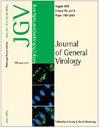急性和持续性副流感病毒 5 型感染中的液-液相包涵体
IF 3.6
4区 医学
Q2 BIOTECHNOLOGY & APPLIED MICROBIOLOGY
引用次数: 0
摘要
细胞质包涵体(IB)是单链、非片段、负链 RNA 病毒(Mononegavirales)感染的常见特征,被认为是病毒转录和复制活跃的区域。在这里,我们跟踪了感染副黏液病毒 5 型副流感病毒(PIV5)的持久性和溶解性/急性变体的细胞中 IB 的形成和维持动态。我们发现,小包涵体的数量在感染后约 12 h 前迅速增加。此后,包涵体的数量减少,但体积增大,这可能是由于这些液态细胞器的融合可能会被渗透休克细胞破坏。在这些时间段内,感染溶解性/急性和持续性病毒的细胞中包涵体的形成没有明显差异。在持续感染 PIV5 的细胞中,包括几乎没有病毒转录或复制的细胞中,也很容易检测到包涵体。原位杂交显示,基因组 RNA 主要位于 IBs 中,而病毒 mRNA 则更分散地分布在整个细胞质中。在感染后的早期,一些(但不是全部)IB 显示出 5-乙炔基尿嘧啶(5EU)的整合,它被整合到新合成的 RNA 中。这些结果有力地表明,虽然基因组 RNA 存在于所有 IB 中,但 IB 并非病毒转录和复制的持续活跃场所。通过对持续感染的细胞进行渗透休克来破坏 IB 并不会增加病毒蛋白质的合成,这表明在持续感染的细胞中,大部分病毒基因组处于抑制状态。本文讨论了 IB 在 PIV5 复制以及建立和维持持久性中的作用。本文章由计算机程序翻译,如有差异,请以英文原文为准。
Liquid–liquid phase inclusion bodies in acute and persistent parainfluenaza virus type 5 infections
Cytoplasmic inclusion bodies (IBs) are a common feature of single-stranded, non-segmented, negative-strand RNA virus (Mononegavirales) infections and are thought to be regions of active virus transcription and replication. Here we followed the dynamics of IB formation and maintenance in cells infected with persistent and lytic/acute variants of the paramyxovirus, parainfluenza virus type 5 (PIV5). We show that there is a rapid increase in the number of small inclusions bodies up until approximately 12 h post-infection. Thereafter the number of inclusion bodies decreases but they increase in size, presumably due to the fusion of these liquid organelles that can be disrupted by osmotically shocking cells. No obvious differences were observed at these times between inclusion body formation in cells infected with lytic/acute and persistent viruses. IBs are also readily detected in cells persistently infected with PIV5, including in cells in which there is little or no ongoing virus transcription or replication. In situ hybridization shows that genomic RNA is primarily located in IBs, whilst viral mRNA is more diffusely distributed throughout the cytoplasm. Some, but not all, IBs show incorporation of 5-ethynyl-uridine (5EU), which is integrated into newly synthesized RNA, at early times post-infection. These results strongly suggest that, although genomic RNA is present in all IBs, IBs are not continuously active sites of virus transcription and replication. Disruption of IBs by osmotically shocking persistently infected cells does not increase virus protein synthesis, suggesting that in persistently infected cells most of the virus genomes are in a repressed state. The role of IBs in PIV5 replication and the establishment and maintenance of persistence is discussed.
求助全文
通过发布文献求助,成功后即可免费获取论文全文。
去求助
来源期刊

Journal of General Virology
医学-病毒学
CiteScore
7.70
自引率
2.60%
发文量
91
审稿时长
3 months
期刊介绍:
JOURNAL OF GENERAL VIROLOGY (JGV), a journal of the Society for General Microbiology (SGM), publishes high-calibre research papers with high production standards, giving the journal a worldwide reputation for excellence and attracting an eminent audience.
 求助内容:
求助内容: 应助结果提醒方式:
应助结果提醒方式:


